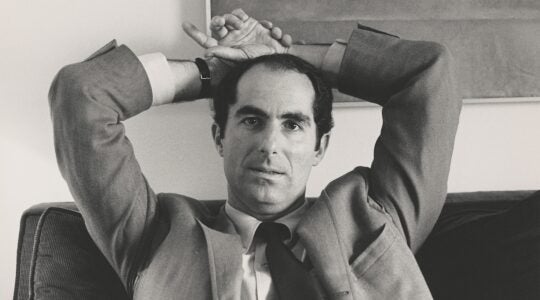On the eve of Tisha b’Av 15 years ago, I wrote one of my first columns in my new post here about the rabbinic teaching that the Holy Temple was destroyed in 586 BCE and again in 70 AD on Tisha b’Av (the ninth of Av) because of sinat chinam, or causeless hatred, among the Jewish people.
I tried to make the point that the problem still plagues us, and noted that Jews of all stripes, from Orthodox to Reform to secular, can and should find things to admire about each other.
The very day the article was published I received a call from a local rabbi who said he was extremely upset about what I had written. I was taken aback because frankly, the
essay had a bit of a motherhood-and-apple pie quality to it. I was still trying to find my voice, keenly aware that I was writing for a large and, I imagined, passionate and somewhat cantankerous audience.
So I wondered aloud what had offended the rabbi. He told me he was angry that his branch of Judaism, which he described as the only authentic one, was mentioned in the same sentence as the other denominations.
It was a disturbing but liberating lesson for me, teaching me that since whatever I wrote was bound to offend someone, I might as well be direct.
Looking back today, on the eve of another Tisha b’Av (next Saturday night and Sunday, Aug. 9-10) and about to mark the saddest day on the Jewish calendar through fasting and prayer, I question whether the Jewish community — locally, nationally or globally — has moved any closer in the last 15 years.
There are positive signs. In communal life, there has been a growing partnership among Jewish federations, philanthropic foundations, synagogues, day schools and campus Hillels in recognition of their interdependence, and a sense of common mission in terms of enhancing Jewish identification, education, practice and involvement. Among the results have been federation support for social workers within synagogues, for example, and, most dramatically, the cooperative creation and flourishing of Birthright Israel, which has provided free 10-day trips to Israel for almost 200,000 young people, aged 18-26, from around the world.
At the same time, the gap is widening between those Jews who choose to identify with the community and those who are falling away from Jewish connection and affiliation, particularly among the youth.
On an international scale, similarly, the divide is growing between those who identify strongly with and support Israel and those who do not. And the ranks of the latter group appear to be growing. One clear indication is the discomfort during the Second Intifada of so many Jewish students on campus who were embarrassed by or lacking in knowledge of Israel’s actions during that painful time, or both.
Among the various streams of Judaism, there have been examples of cooperation, like communal groups studying texts together, and a move away from restrictive denominational labels. But there also have been cases of resentment, divisiveness and even violence, particularly in Israel where some elements of the secular and Orthodox communities have zero tolerance for each other. (The Ne’eman Commission, a noble effort a decade ago to solve the conversion crisis in Israel, ultimately had little impact.)
Jack Wertheimer, professor of American Jewish history at the Jewish Theological Seminary, wrote a report in 2005, commissioned by the American Jewish Committee, asserting that there has been a decline in interdenominational tensions in the U.S. in recent years — but not necessarily for positive reasons. He argued in his study, “All Quiet On The Religious Front?” that the relative calm has come not from consensus on issues of contention — like conversion, intermarriage, divorce, homosexuality, gay marriage and the definition of who is a Jew — but from a widespread distaste for the kind of mudslinging among religious leaders that was common in the mid-1980s and early 1990s.
Wertheimer argued, though, that such debate is healthy — if it can avoid nasty put-downs — and further, that without confronting the real problems we face as one people, we are only fooling ourselves and putting off the inevitable split.
He still feels that way, he told me this week, noting, for example, that both the Orthodox and Reform movements remain convinced the other will disappear.
Wertheimer’s question, in turn, is how does one differentiate between sinat chinam and healthy debate?
“I think there’s real value to challenging each other, as opposed to name-calling,” he said.
Steven Bayme, national director of contemporary Jewish life for the American Jewish Committee, agrees.
He asserts that “the trend toward assimilation blurs the line of who is a Jew, which is corrosive for Jewish peoplehood.” Better to thrash out some identity boundaries, painful as that could be, he believes, than continue down the path of least resistance — and least meaning.
There may be short-term benefits to “keeping the lid on” communal debate, Bayme said, “but in the long run we’d better learn how to argue” with each other if we want to stay together.
It’s true. Strong commitment to an ideology is a sign of vibrancy and passion. Empty slogans proclaiming “We Are One” may sound to young people too much like “We Don’t Care.”
Bayme noted that 15 years ago the Oslo peace process was supposed to free Israel up to deal with internal Jewish conflicts. Instead, its collapse, and the resulting rise of intifada terror, anti-Semitism and the Iran nuclear threat has served, to some degree, in unifying Jews against exterior enemies.
But the day of reckoning for Jewish unity lies just ahead. The key is to express our differences with genuine concern for each other, to hear each other out rather than write each other out.
Such an approach calls to mind the antidote to sinat chinam proposed by Rabbi Avraham Yitzchok Kook, the chief rabbi of Palestine in the 1920s, who advocated ahavat chinam, or causeless love: caring about a fellow Jew simply because he or she has a Jewish soul.
We’ve got a long way to go, but it’s a goal to strive for as we approach Tisha B’Av, the centuries-old reminder that if our divisions are not addressed, we may well prove to be our own worst enemies.
The New York Jewish Week brings you the stories behind the headlines, keeping you connected to Jewish life in New York. Help sustain the reporting you trust by donating today.





